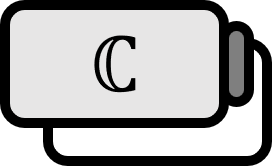Derivation of Triple Angle Formulas for Trigonometric Functions Using De Moivre's Theorem
Formulas
$$ \sin 3\theta = 3 \sin \theta - 4 \sin^{3} {\theta} \\ \cos 3\theta = 4 \cos^{3} {\theta} - 3 \cos \theta $$
Description
Traditional transformation formulas usually can be derived by using the addition formulas for trigonometric functions multiple times.
For instance, the double angle formula is derived by substituting $b=a$ into $\sin(a + b ) = \sin {a} \cos {b} + \sin {b} \cos {a}$ to get $\sin(a+a) = \sin{2a} = 2 \sin{a} \cos{a}$. Of course, there’s no issue with deriving triple and quadruple angle formulas in this way. However, by using complex analysis, one can derive these formulas more elegantly.
The derivation process itself, rather than the formulas alone, is useful, so make sure to familiarize yourself with it.
Derivation
De Moivre’s Theorem: If $z = r \text{cis} \theta$, then $z^n = r^n \text{cis} n\theta$
According to De Moivre’s Theorem, if we say $r=1$, then $$ (\cos{3\theta} + i \sin{3 \theta}) = \text{cis} 3\theta = z^3 = (\cos{\theta} + i \sin{\theta})^3 $$ The necessary and sufficient condition for this equation to hold is for the real and imaginary parts on both sides to be equal respectively. To expand the right-hand side, we use the binomial theorem, resulting in $$ \begin{align*} (\cos{3\theta} + i \sin{3 \theta}) =& (\cos{\theta} + i \sin{\theta})^3 \\ =& \cos ^3 {\theta} + i 3 \cos ^2 {\theta} \sin{\theta} - 3 \cos {\theta} \sin ^2 {\theta} - i \sin ^3 {\theta} \\ =& ( \cos ^3 {\theta} - 3 \cos {\theta} \sin ^2 {\theta} ) + i ( 3 \cos ^2 {\theta} \sin{\theta} - \sin ^3 {\theta} ) \\ =& (4 \cos^{3} {\theta} - 3 \cos \theta) + i ( 3 \sin \theta - 4 \sin^{3} {\theta} ) \end{align*} $$ In other words, $$ \sin 3\theta = 3 \sin \theta - 4 \sin^{3} {\theta} \\ \cos 3\theta = 4 \cos^{3} {\theta} - 3 \cos \theta $$
■
Application
As you can see from the idea of using the binomial theorem, this isn’t a derivation method solely tied to triple angles. It can be extended to natural numbers as well and expressed as a series to obtain a general formula. Also, by tracing back through the derivation process, one can find that it’s possible to split higher-order trigonometric terms into several terms.
